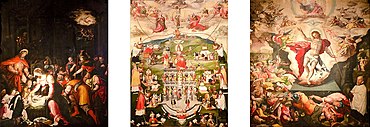Wrisberg epitaph
The Wrisberg epitaph is a triptych that the Hildesheim artist Johannes Hopffe († 1615) created around 1585 as an epitaph for the canon Ernst von Wrisberg . The original frame has not been preserved. Of the picture panels that were relocated during World War II, the middle one could be seen until January 2010 in the south transept of Hildesheim Cathedral . During the cathedral renovation (2010–2014) the three panels were exhibited in a reconstructed frame in the Weser Renaissance Museum in Brake Castle ( Lemgo ). They have been in the Hildesheim Cathedral Museum since 2015 .
Emergence

Ernst von Wrisberg , member of the Hildesheim cathedral chapter since 1547 , donated three panel paintings for the northern choir wall of Hildesheim cathedral around 1585 . They were originally inserted in a sculptural frame with caryatids and family crests and provided with Latin inscriptions. The frames and inscriptions are lost, but the texts have been recorded.
The dedication was as follows:
- ERNESTVS A WRISBERG CANON [ICVS] HVIVS ECCLESIAE VIVVS SIBI POSVIT NE DE SEPVLCHRO TESTAMENTARII ET HAEREDES SOLLICITI ESSENT NEVE VIVORVM NEGLIGENTIA OBESSET MORTVO VALETE POSTERI
- “Ernst von Wrisberg, canon of this church, sat down [this memorial] during his lifetime so that the executors and heirs do not have to worry about a tomb or the neglect of the living is detrimental to the dead. Farewell, you later ones. "
Despite this precaution, a stone epitaph was placed in the cathedral cloister for Wrisberg after his death on October 4, 1590.
Style and description
The three large panels in the Mannerist style have the same height, but slightly different width. The exterior panels show, based on models from the Italian Renaissance , the birth and resurrection of Christ.
The most original piece is the central panel. It is considered a painted catechism of Catholic reform . The Catholic ecclesiology and doctrine of the sacraments , renewed by the Council of Trent, are illustrated with a counter-Reformation accent . The picture shows the heavenly world of God and the saints and the temporal-earthly world on two floors, which are separated and connected at the same time. The connection is in the central axis. The crucified one, as the second person of the Trinity between God the Father and the dove of the Holy Spirit, releases the streams of grace from his wounds, which spread through the baptismal font to the other sacraments and through them to the people. In the center, a red-robed woman with a tiara as the personification of the church is enthroned on a magnificent Renaissance architecture. A long procession of people comes naked from a cave on the far horizon, goes into the baptismal font and leaves it dressed in white, continues on to the palace of the church and from there divides into bourgeois dressed individuals who receive the sacraments in different life situations or, leaving the floor of the church, plunging into the abyss at the lower edge of the picture.
Which - apart from the "entrance gate" of baptism - are six sacraments and their oversized donors
- Left:
Anointing of the sick ( unctio ; priest with choir shirt and stole )
Ordination ( ordo ; bishop with golden choir cloak )
Confirmation ( Confirmatio ; bishop with red choir cloak)
- right:
Marriage ( matrimonium ; priest with choir shirt and stole)
Confession ( Poenitentia ; priest with choir shirt and stole)
The heavenly and earthly churches as well as the church and the sacraments are connected with iron chains.
Web links
- Historical information (inschriften.net)
- Information from the Diocese of Hildesheim
- The three panels of the epitaph in the reconstructed frame (Weser Renaissance Museum Schloss Brake)
Individual evidence
- ↑ a b Comment on the grave slab (inschriften.net)







